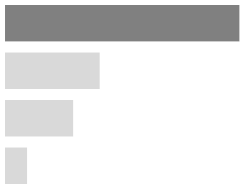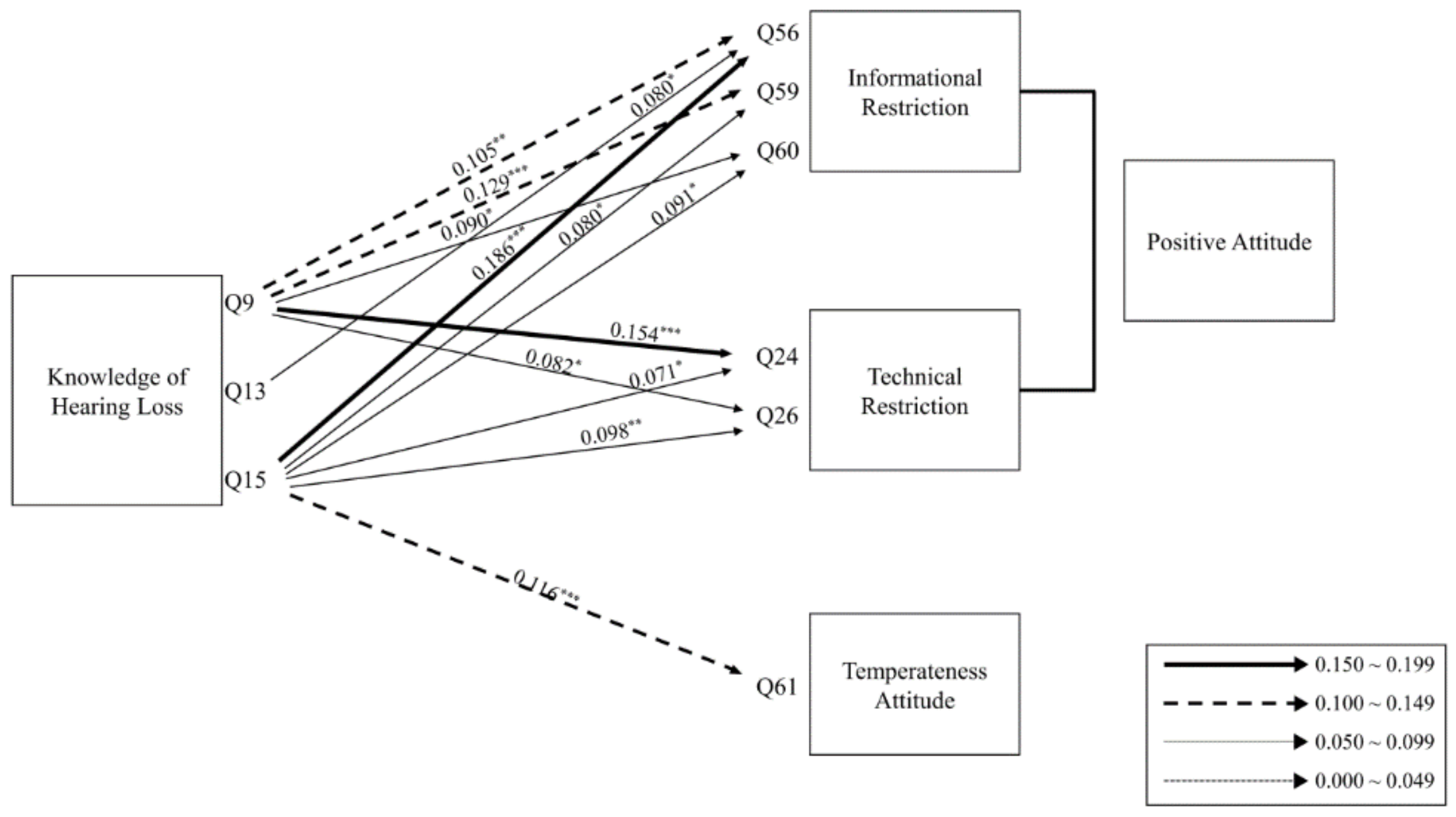Use of Personal Listening Devices and Knowledge/Attitude for Greater Hearing Conservation in College Students: Data Analysis and Regression Model Based on 1009 Respondents
Abstract
1. Introduction
- RQ1. Which behavior involved in using PLDs might lead to a self-reported and experienced hearing problem?
- RQ2. Does knowledge of hearing loss among PLD users influence their attitude toward hearing conservation?
2. Materials and Methodology
2.1. Phase 1. Analysis of the Questionnaire
2.1.1. Development of the Personal Listening Device and Hearing Questionnaire-Korean (PLDHQ-K)
2.1.2. Participants
2.1.3. Data Analysis
2.2. Phase 2. The Regression Model
2.2.1. Research Hypotheses
2.2.2. Statistical Analysis
3. Results and Discussion
3.1. Phase 1. Analysis of Questionnaire
3.1.1. Self-Evaluation for Hearing Conditions and the Experience of Noise Exposure
3.1.2. Knowledge of Factors Triggering Hearing Loss and Hearing Loss Prevention
3.1.3. Preference for Personal Listening Device (PLD) Use
3.1.4. Use Pattern of PLDs
3.1.5. Reasons for PLD Use
3.1.6. Hearing Effects from PLD Use
3.1.7. Opinion Regarding Use of PLDs
3.1.8. Knowledge of and Attitude Toward Regulations and Preference Type for Education
3.1.9. Comparison of Responses for PLDHQ and PLDHQ-K
3.2. The Regression Model
4. Conclusions
Author Contributions
Funding
Acknowledgments
Conflicts of Interest
Abbreviations
| H-1 | Hypothesis 1 |
| H-2 | Hypothesis 2 |
| KMO | Kaiser–Meyer–Olkin |
| NIOSH | National Institute for Occupational Safety and Health |
| NIHL | Noise Induced Hearing Loss |
| OSHA | Occupational Safety and Health Administration |
| PCA | Principal component analysis |
| PLDHQ | Personal Listening Device and Hearing Questionnaire |
| PLDHQ-K | Korean version of the PLDHQ |
| PLDs | Personal Listening Devices |
| PLLs | Preferred Listening Levels |
| WHO | World Health Organization |
Appendix A
| Item Number | Response | Number of Respondents (%) | |
|---|---|---|---|
| Q5. How often are you exposed to noisy environments? | Never | 21(2.1) |  |
| Rarely | 210(20.8) | ||
| Sometimes | 476(47.2) | ||
| Frequently | 240(23.8) | ||
| Always | 62(6.1) | ||
| Total | 1009 | ||
| Q17. Mark your current hearing condition as 1–10 (1: the worst hearing level, 10: the best hearing level) | 1 | 2(0.2) |  |
| 2 | 6(0.6) | ||
| 3 | 41(4.1) | ||
| 4 | 79(7.8) | ||
| 5 | 114(11.3) | ||
| 6 | 151(15) | ||
| 7 | 247(24.5) | ||
| 8 | 245(24.3) | ||
| 9 | 93(9.2) | ||
| 10 | 31(3.1) | ||
| Total | 1009 | ||
| Q35. Do you think you have some difficulties when hearing? | Yes | 119(11.8) |  |
| No | 540(53.5) | ||
| Maybe | 229(22.7) | ||
| I don’t know | 121(12) | ||
| Total | 1009 | ||
| Q36. If you have hearing difficulties, what is their cause? | Ear infections | 77(7.7) |  |
| Fever | 9(0.9) | ||
| Noise | 150(14.9) | ||
| Trauma | 8(0.8) | ||
| Drugs | 1(0.1) | ||
| Birth defects | 28(2.8) | ||
| PLD use | 306(30.4) | ||
| Do not have any | 323(32.1) | ||
| Unknown | 104(10.3) | ||
| N/A | 3 | ||
| Total | 1006 | ||
| Q65. If you already have hearing loss, do you think that using PLDs is one of the causes? | Yes | 485(48.1) |  |
| No | 130(12.9) | ||
| Maybe | 314(31.1) | ||
| I don’t know | 80(7.9) | ||
| Total | 1009 | ||
Appendix B
| Item Number | Response | Number of Respondents (%) | |
|---|---|---|---|
| Q6. Do you think that people with hearing loss no longer need to worry about hearing loss from hazardous noise? | Yes | 100(9.9) |  |
| No | 728(72.2) | ||
| Maybe | 131(13) | ||
| I don’t know | 50(5) | ||
| Total | 1009 | ||
| Q7. Do you think that inserting cotton in the ears can prevent hearing loss caused by loud noise? | Yes | 166(16.5) |  |
| No | 370(36.7) | ||
| Maybe | 337(33.4) | ||
| I don’t know | 136(13.5) | ||
| Total | 1009 | ||
| Q8. Do you think that noise-induced hearing loss can be prevented in advance? | Yes | 668(66.2) |  |
| No | 97(9.6) | ||
| Maybe | 198(19.6) | ||
| I don’t know | 46(4.6) | ||
| Total | 1009 | ||
| Q9. Do you think tinnitus (or ringing in the ears) is a symptom of overexposure to hazardous noise? | Yes | 484(48) |  |
| No | 140(13.9) | ||
| Maybe | 275(27.3) | ||
| I don’t know | 110(10.9) | ||
| Total | 1009 | ||
| Q11. If you do not hear another person’s voice correctly or you ask for repeats saying “huh?” or “what?” is this a symptom of hearing loss? | Yes | 301(29.8) |  |
| No | 339(33.6) | ||
| Maybe | 282(28) | ||
| I don’t know | 87(8.6) | ||
| Total | 1009 | ||
| Q13. Do you think it is a sign of hearing loss if people’s voices sound muffled or as if people are mumbling? | Yes | 335(33.2) |  |
| No | 266(26.4) | ||
| Maybe | 309(30.6) | ||
| I don’t know | 99(9.8) | ||
| Total | 1009 | ||
| Q15. Do you think raising the volume of a TV or a radio is a symptom of hearing loss? | Yes | 570(56.5) |  |
| No | 155(15.4) | ||
| Maybe | 244(24.2) | ||
| I don’t know | 40(4) | ||
| Total | 1009 | ||
Appendix C
| Item Number | Response | Number of Respondents (%) | |
|---|---|---|---|
| Q18. Do you currently use a PLD, such as a smartphone or MP3 player? | Yes | 985(97.6) |  |
| No | 24(2.4) | ||
| Total | 1009 | ||
| Q19. If you have a PLD, what kind of device is it? | Smartphone | 946(93.8) |  |
| MP3 player | 26(2.6) | ||
| Tablet | 9(0.9) | ||
| Notebook | 8(0.8) | ||
| Other | 20(2) | ||
| Total | 1009 | ||
| Q20. If you have a PLD, how did you get it? | Given to me (choose) | 115(11.4) |  |
| Given to me (not choose) | 50(5) | ||
| I purchased it | 810(80.3) | ||
| Do not own one | 24(2.4) | ||
| Other | 10(1) | ||
| Total | 1009 | ||
| Q21. Considering your current financial status, is it easy for you to purchase a PLD? | Yes | 471(46.7) |  |
| No | 301(29.8) | ||
| Maybe | 187(18.3) | ||
| I don’t know | 50(5) | ||
| Total | 1009 | ||
| Q22. How many of your friends use PLDs? Check a percentage. | Less than 25% | 36(3.6) |  |
| 26–50% | 62(6.1) | ||
| 51–75% | 133(13.2) | ||
| 76–100% | 778(77.1) | ||
| Total | 1009 | ||
| Q23. If you could choose any PLDs in the store, which kind of PLD would you prefer? | Smartphone | 812(80.5) |  |
| MP3 player | 62(6.1) | ||
| Tablet | 72(7.1) | ||
| Notebook | 47(4.7) | ||
| Other (please specify) | 16(1.6) | ||
| Total | 1009 | ||
| Q29. Which manufacturer of PLDs do you currently use? | Samsung | 518(51.4) |  |
| LG | 99(9.8) | ||
| Apple | 355(35.2) | ||
| SONY | 7(0.7) | ||
| Lenovo | 2(0.2) | ||
| Other (please specify) | 28(2.8) | ||
| Total | 1009 | ||
| Q30. What kind of PLD did you use before using your current one? | Smartphone | 708(70.2) |  |
| MP3 player | 236(23.4) | ||
| Tablet | 18(1.8) | ||
| Notebook | 31(3.1) | ||
| Other (please specify) | 16(1.6) | ||
| Total | 1009 | ||
| Q31. What type of earphones do you usually use to listen to music on your PLD? | Earbuds | 672(66.6) |  |
| Canal earphone | 274(27.2) | ||
| Headset | 34(3.4) | ||
| Custom earpieces | 6(0.6) | ||
| Other (please specify) | 23(2.3) | ||
| Total | 1009 | ||
| Q32. Would you consider purchasing customized earphones or headphones for your PLD to reduce background noise (e.g., vehicle, conversation, other noise)? | Yes | 471(46.7) |  |
| No | 317(31.4) | ||
| Maybe | 140(13.9) | ||
| I don’t know | 81(8) | ||
| Total | 1009 | ||
| Q33. How much would you be willing to pay for a customized earphone or headphone? | Under $25 | 466(46.2) |  |
| $26–$50 | 347(34.4) | ||
| $51–$100 | 97(9.6) | ||
| Over $100 | 99(9.8) | ||
| Total | 1009 | ||
Appendix D
| Item Number | Response | Number of Respondents (%) | |
|---|---|---|---|
| Q34. How long have you been using a PLD? | Less than 1 year | 105(10.4) |  |
| 1 to 2 years | 127(12.6) | ||
| More than 2 years | 777(77) | ||
| Total | 1009 | ||
| Q37. How many days do you use your PLD each week? Check the number of days that apply. | 1 | 34(3.4) |  |
| 2 | 40(4) | ||
| 3 | 95(9.4) | ||
| 4 | 114(11.3) | ||
| 5 | 151(15) | ||
| 6 | 97(9.6) | ||
| 7 | 478(47.4) | ||
| Total | 1009 | ||
| Q38. How many hours do you use a PLD continuously each time you use one? | Less than 1/4 | 35(3.5) |  |
| 1/4 to 1/2 | 153(15.2) | ||
| 1/2 to 1 | 352(34.9) | ||
| 1 to 2 | 299(29.6) | ||
| 3 to 4 | 94(9.3) | ||
| More than 4 | 76(7.5) | ||
| Total | 1009 | ||
| Q39. How many hours do you usually use a PLD on the days when you do use your PLD? | Less than 1/4 | 34(3.4) |  |
| 1/4 to 1/2 | 66(6.5) | ||
| 1/2 to 1 | 212(21) | ||
| 1 to 2 | 291(28.8) | ||
| 3 to 4 | 231(22.9) | ||
| More than 4 | 175(17.3) | ||
| Total | 1009 | ||
| Q40. How many times a year do you use a PLD in one place for more than four hours? | 1 to 3 | 379(37.6) |  |
| 4 to 6 | 188(18.6) | ||
| 7 to 10 | 121(12) | ||
| 11 to 20 | 85(8.4) | ||
| 21 or more | 236(23.4) | ||
| Total | 1009 | ||
| Q41. If you can set the volume of your PLD from 1 to 10, at which level do you typically set it? | 1 | 22(2.2) |  |
| 2 | 56(5.6) | ||
| 3 | 112(11.1) | ||
| 4 | 148(14.7) | ||
| 5 | 172(17.1) | ||
| 6 | 193(19.1) | ||
| 7 | 170(16.9) | ||
| 8 | 96(9.5) | ||
| 9 | 24(2.4) | ||
| 10 | 16(1.6) | ||
| Total | 1009 | ||
| Q42. Of the five responses, how do you consider the volume level on your PLD? | Very soft | 28(2.8) |  |
| Soft | 148(14.7) | ||
| Medium | 535(53) | ||
| Loud | 267(26.5) | ||
| Very loud | 31(3.1) | ||
| Total | 1009 | ||
| Q43. When you listen to your favorite music, do you increase the volume on your PLD? | Yes | 467(46.3) |  |
| No | 357(35.4) | ||
| Maybe | 161(16) | ||
| I don’t know | 24(2.4) | ||
| Total | 1009 | ||
| Q44. In noisy background conditions, do you increase the volume on your PLD? | Yes | 771(76.4) |  |
| No | 127(12.6) | ||
| Maybe | 100(9.9) | ||
| I don’t know | 11(1.1) | ||
| Total | 1009 | ||
| Q45. When you are exercising, do you increase the volume on your PLD? | Yes | 451(44.7) |  |
| No | 380(37.7) | ||
| Maybe | 137(13.6) | ||
| I don’t know | 41(4.1) | ||
| Total | 1009 | ||
| Q46. During which activities do you usually use a PLD (can select multiple responses)? | Studying | 482(13.8) |  |
| Walking/jogging | 605(17.3) | ||
| Driving | 154(4.4) | ||
| Biking | 115(3.3) | ||
| Skiing/snowboarding | 11(0.3) | ||
| Working | 192(5.5) | ||
| Exercising | 431(12.3) | ||
| During class | 33(0.9) | ||
| Relaxing | 633(18.1) | ||
| Riding on planes | 149(4.3) | ||
| Public transport | 646(18.5) | ||
| Other | 44(1.3) | ||
| Total | 3495 | ||
| Q74. When listening to music, do you adjust the volume of your PLD to minimize the inconvenience of others nearby? | Strongly agree | 388(38.5) |  |
| Moderately agree | 346(34.3) | ||
| Neutral | 174(17.3) | ||
| Moderately disagree | 68(6.8) | ||
| Strongly disagree | 32(3.2) | ||
| N/A | 1 | ||
| Total | 1009 | ||
Appendix E
| Item Number | Response | Number of Respondents (%) | |
|---|---|---|---|
| Q68. Do you agree that the main reason why you use a PLD is to listen to music? | Strongly agree | 559(55.4) |  |
| Moderately agree | 302(39.9) | ||
| Neutral | 113(11.2) | ||
| Moderately disagree | 28(2.8) | ||
| Strongly disagree | 7(0.7) | ||
| Total | 1009 | ||
| Q69. Do you often use a PLD to help you relax? | Strongly agree | 225(22.3) |  |
| Moderately agree | 379(37.6) | ||
| Neutral | 216(21.4) | ||
| Moderately disagree | 136(13.5) | ||
| Strongly disagree | 53(5.3) | ||
| Total | 1009 | ||
| Q70. Do you often use a PLD to isolate yourself from others? | Strongly agree | 161(16) |  |
| Moderately agree | 305(30.2) | ||
| Neutral | 204(20.2) | ||
| Moderately disagree | 218(21.6) | ||
| Strongly disagree | 121(12) | ||
| Total | 1009 | ||
| Q71. Do you often use a PLD as a fashion item? | Strongly agree | 33(3.3) |  |
| Moderately agree | 71(7) | ||
| Neutral | 114(11.3) | ||
| Moderately disagree | 312(30.9) | ||
| Strongly disagree | 479(47.5) | ||
| Total | 1009 | ||
| Q72. Do you often use a PLD to focus on something specific, such as study or work? | Strongly agree | 187(18.5) |  |
| Moderately agree | 365(36.2) | ||
| Neutral | 219(21.7) | ||
| Moderately disagree | 138(13.7) | ||
| Strongly disagree | 100(9.9) | ||
| Total | 1009 | ||
| Q73. Do you intend to use your PLD as a form of rebellion (e.g., to escape from having conversation with others)? | Strongly agree | 56(5.6) |  |
| Moderately agree | 176(17.4) | ||
| Neutral | 166(16.5) | ||
| Moderately disagree | 248(24.6) | ||
| Strongly disagree | 363(36) | ||
| Total | 1009 | ||
| Q75. Do you often use a PLD when you feel bored? | Strongly agree | 375(37.2) |  |
| Moderately agree | 408(40.4) | ||
| Neutral | 157(15.6) | ||
| Moderately disagree | 44(4.4) | ||
| Strongly disagree | 25(2.5) | ||
| Total | 1009 | ||
| Q76. Do you often use a PLD because of its convenience? | Strongly agree | 437(43.3) |  |
| Moderately agree | 371(36.8) | ||
| Neutral | 149(14.8) | ||
| Moderately disagree | 37(3.7) | ||
| Strongly disagree | 15(1.5) | ||
| Total | 1009 | ||
| Q77. Do you use a PLD often because you are a “high-tech enthusiast?” | Strongly agree | 120(11.9) |  |
| Moderately agree | 137(13.6) | ||
| Neutral | 223(22.1) | ||
| Moderately disagree | 300(29.7) | ||
| Strongly disagree | 229(22.7) | ||
| Total | 1009 | ||
Appendix F
| Item Number | Response | Number of Respondents (%) | |
|---|---|---|---|
| Q10. How often do you experience tinnitus? | Never | 181(17.9) |  |
| Rarely | 408(40.4) | ||
| Sometimes | 358(35.5) | ||
| Frequently | 53(5.3) | ||
| Always | 9(0.9) | ||
| Total | 1009 | ||
| Q12. How often do you ask for repeats and say “huh?” or “what?” because you do not hear what other persons have said correctly? | Never | 49(4.9) |  |
| Rarely | 275(27.3) | ||
| Sometimes | 516(51.1) | ||
| Frequently | 153(15.2) | ||
| Always | 16(1.6) | ||
| Total | 1009 | ||
| Q14. How often do you hear people’s voices sounding muffled or as though they are mumbling? | Never | 201(19.9) |  |
| Rarely | 467(46.3) | ||
| Sometimes | 286(28.3) | ||
| Frequently | 51(5.1) | ||
| Always | 4(0.4) | ||
| Total | 1009 | ||
| Q16. How often do you increase the volume of TV or radio to have it loud enough? | Never | 61(6.1) |  |
| Rarely | 323(32) | ||
| Sometimes | 478(47.4) | ||
| Frequently | 123(12.2) | ||
| Always | 24(2.4) | ||
| Total | 1009 | ||
| Q47. When you are using a PLD, can other people around you hear your PLD’s sound? | Yes | 121(12) |  |
| No | 671(66.5) | ||
| Maybe | 122(12.1) | ||
| I don’t know | 95(9.4) | ||
| Total | 1009 | ||
| Q48. Have family, friends, or strangers warned/asked/demanded that you to turn down the volume of your PLD? | Never | 449(44.5) |  |
| Rarely | 344(34.1) | ||
| Sometimes | 184(18.2) | ||
| Frequently | 26(2.6) | ||
| Always | 6(0.6) | ||
| Total | 1009 | ||
| Q49. After using a PLD, have you ever experienced tinnitus? | Never | 454(45) |  |
| Rarely | 347(34.4) | ||
| Sometimes | 183(18.2) | ||
| Frequently | 20(2) | ||
| Always | 4(0.4) | ||
| N/A | 1 | ||
| Total | 1009 | ||
| Q50. After using a PLD, have you ever felt like your ears were full or fuzzy? | Never | 448(44.4) |  |
| Rarely | 321(31.8) | ||
| Sometimes | 209(20.7) | ||
| Frequently | 28(2.8) | ||
| Always | 3(0.3) | ||
| Total | 1009 | ||
| Q51. After using a PLD, have you ever increased the volume son your TV or radio to hear it better? | Never | 379(37.6) |  |
| Rarely | 297(29.4) | ||
| Sometimes | 259(25.7) | ||
| Frequently | 68(6.7) | ||
| Always | 6(0.6) | ||
| Total | 1009 | ||
| Q52. After using a PLD, have you ever felt that people nearby are mumbling, or their voices sound muffled? | Never | 450(44.7) |  |
| Rarely | 353(35) | ||
| Sometimes | 173(17.2) | ||
| Frequently | 32(3.2) | ||
| Always | 0(0) | ||
| N/A | 1 | ||
| Total | 1009 | ||
| Q53. After using a PLD, have you ever asked someone to repeat by saying “huh?” or “what?” because you did not correctly hear what others said? | Never | 306(30.3) |  |
| Rarely | 317(31.4) | ||
| Sometimes | 284(28.2) | ||
| Frequently | 92(9.1) | ||
| Always | 10(1) | ||
| Total | 1009 | ||
| Q67. Have you ever realized you were in a dangerous situation while using a PLD (e.g., when crossing the road, or had an absence of attention while driving)? | Strongly agree | 49(4.9) |  |
| Moderately agree | 174(17.2) | ||
| Neutral | 367(36.4) | ||
| Moderately disagree | 276(27.4) | ||
| Strongly disagree | 143(14.2) | ||
| Total | 1009 | ||
Appendix G
| Item Number | Response | Number of Respondents (%) | |
|---|---|---|---|
| Q54. At what age do you give permission to others to regularly listen to music? | Younger than 5 years | 12(1.2) |  |
| 5 to 10 years | 63(6.2) | ||
| 11 to 13 years | 320(31.7) | ||
| 14 to 16 years | 386(38.3) | ||
| Older than 16 years | 158(15.7) | ||
| I don’t know | 70(6.9) | ||
| Total | 1009 | ||
| Q55. Do you think that it is dangerous to use PLDs in some situations (e.g., driving, biking, snowboarding)? | Strongly agree | 562(55.7) |  |
| Moderately agree | 276(27.4) | ||
| Neutral | 107(10.6) | ||
| Moderately disagree | 44(4.4) | ||
| Strongly disagree | 20(2) | ||
| Total | 1009 | ||
| Q56. Do you think that using PLDs at loud listening levels can damage hearing? | Strongly agree | 609(60.4) |  |
| Moderately agree | 305(30.3) | ||
| Neutral | 70(6.9) | ||
| Moderately disagree | 16(1.6) | ||
| Strongly disagree | 8(0.8) | ||
| N/A | 1 | ||
| Total | 1009 | ||
| Q57. Do you believe that it is unimportant to follow the manufacturer’s warnings about the safe use of PLDs (less listening time at a high volume)? | Strongly agree | 118(11.7) |  |
| Moderately agree | 218(21.6) | ||
| Neutral | 293(29) | ||
| Moderately disagree | 244(24.2) | ||
| Strongly disagree | 136(13.5) | ||
| Total | 1009 | ||
| Q58. Do you refuse to change your use patterns for PLDs, even though scientific evidence suggests that using a PLD at high volumes can cause hearing loss? | Yes | 150(14.9) |  |
| No | 484(48) | ||
| Maybe | 268(26.6) | ||
| I don’t know | 107(10.6) | ||
| Total | 1009 | ||
| Q59. Do you think that PLDs should carry a warning like cigarettes do, such as, “Listening to loud music for a prolonged time can damage your hearing?” | Strongly agree | 247(24.5) |  |
| Moderately agree | 375(37.2) | ||
| Neutral | 243(24.1) | ||
| Moderately disagree | 102(10.1) | ||
| Strongly disagree | 42(4.2) | ||
| Total | 1009 | ||
| Q60. To reduce the risk of hearing loss, do you think people should decrease the volume steps on their PLDs rather than only limiting their listening time? | Strongly agree | 259(25.7) |  |
| Moderately agree | 439(43.5) | ||
| Neutral | 269(26.7) | ||
| Moderately disagree | 38(3.8) | ||
| Strongly disagree | 4(0.3) | ||
| Total | 1009 | ||
| Q66. If you are concentrating on using your PLD, do you fear you may not be aware of situations that are dangerous to you or others? | Yes | 713(70.7) |  |
| No | 112(11.1) | ||
| Maybe | 137(13.6) | ||
| I don’t know | 47(4.7) | ||
| Total | 1009 | ||
Appendix H
| Item Number | Response | Number of Respondents (%) | |
|---|---|---|---|
| Q24. Do you think PLD manufacturers, such as Apple and Samsung, should include a volume limit function to prevent hearing loss? | Yes | 565(56) |  |
| No | 228(22.6) | ||
| Maybe | 164(16.25) | ||
| I don’t know | 52(5.15) | ||
| Total | 1009 | ||
| Q25. Do you know that on 29 March 2006, Apple announced software ion their web page to limit a PLDs’ maximum volume steps, with some specific sound loudness information, a caution against listening to loud music for a long period, how to prevent hearing loss from iPod use, and other key information. Are you aware of their communication? | Yes | 157(15.6) |  |
| No | 659(65.3) | ||
| Maybe | 63(6.2) | ||
| I don’t know | 130(12.9) | ||
| Total | 1009 | ||
| Q26. Would you use software for volume control from a PLD manufacturer like Apple or Samsung for you or your child? | Yes | 563(55.8) |  |
| No | 183(18.1) | ||
| Maybe | 175(17.3) | ||
| I don’t know | 88(8.7) | ||
| Total | 1009 | ||
| Q27. Do you agree with the experts who recommend using PLDs at a volume no higher than 60% less than 60 min a day (referred to as the “60–60 rule”)? | Strongly agree | 194(19.3) |  |
| Moderately agree | 431(42.8) | ||
| Neutral | 287(28.5) | ||
| Moderately disagree | 84(8.3) | ||
| Strongly disagree | 12(1.2) | ||
| N/A | 1 | ||
| Total | 1009 | ||
| Q28. Do you think that special recommendations like the “60–60 rule” are a violation of the public’s right to privacy? | Yes | 114(11.3) |  |
| No | 599(59.4) | ||
| Maybe | 151(15) | ||
| I don’t know | 145(14.4) | ||
| Total | 1009 | ||
Appendix I
| Item Number | Response | Number of Respondents (%) | |
|---|---|---|---|
| Q61. Do you think that newscasts, newspapers, and other media have overstated the risk of hearing loss from PLD use? | Yes | 81(8) |  |
| No | 608(60.3) | ||
| Maybe | 113(11.2) | ||
| I don’t know | 207(20.5) | ||
| Total | 1009 | ||
| Q62. Do you want to study and learn more about the potential hearing loss associated with using PLDs? | Yes | 751(74.4) |  |
| No | 258(25.6) | ||
| Total | 1009 | ||
| Q63. If you want to study additional information on how to use PLDs to avoid hearing loss, how would you like to receive it? | 241(23.9) |  | |
| Web sites | 138(13.7) | ||
| From doctors | 89(8.8) | ||
| From experts | 155(15.4) | ||
| From friends, family | 29(2.9) | ||
| TV | 227(22.5) | ||
| Radio | 5(0.5) | ||
| Manufacturer warning | 84(8.3) | ||
| 14(1.4) | |||
| Other | 27(2.7) | ||
| Total | 1009 | ||
| Q64. Whose advice would you seek about safe PLD use and hearing loss? | Doctor | 369(36.6) |  |
| Manufacturer | 60(6) | ||
| Audiologist | 101(10) | ||
| Expert | 424(42) | ||
| Family | 19(1.9) | ||
| Friends | 29(2.9) | ||
| Other | 7(0.7) | ||
| Total | 1009 | ||
References
- Steurer, M.; Simak, S.; Denk, D.M.; Kautzky, M. Does choir singing cause noise-induced hearing loss? Audiol. 1998, 37, 38–51. [Google Scholar] [CrossRef] [PubMed]
- Teie, P.U. Noise-induced hearing loss and symphony orchestra musicians: risk factors, effects, and management. Md. Med J. (Baltimore, Md. 1985) 1998, 47, 13–18. [Google Scholar]
- Metternich, F.U.; Brusis, T. Acute hearing loss and tinnitus caused by amplified recreational music. Laryngorhinootologie 1999, 78, 614–619. [Google Scholar] [CrossRef]
- Meyer-Bisch, C. Epidemiological Evaluation of Hearing Damage Related to Strongly Amplified Music (Personal Cassette Players, Discotheques, Rock Concerts) -High-definition Audiometric Survey on 1364 Subjects. Int. J. Audiol. 1996, 35, 121–142. [Google Scholar] [CrossRef]
- Serra, M.R.; Biassoni, E.C.; Richter, U.; Minoldo, G.; Franco, G.; Abraham, S.; A Carignani, J.; Joekes, S.; Yacci, M.R. Recreational noise exposure and its effects on the hearing of adolescents. Part I: an interdisciplinary long-term study. Int. J. Audiol. 2005, 44, 65–73. [Google Scholar] [CrossRef] [PubMed]
- Ahmed, S.; Fallah, S.; Garrido, B.; Gross, A.; King, M.; Morrish, T.; Pichora-Fuller, K. Use of portable audio devices by university students. Can. Acoust. 2007, 35, 35–52. [Google Scholar]
- Portnuff, C.D.F.; Fligor, B.J.; Arehart, K.H. Adolescent use of MP3 players: A hazard to hearing? In Proceedings of the 34th annual National Hearing Conservation, Atlanta, GA, USA, 12–14 February 2009. [Google Scholar]
- Zogby, J. Survey of Teens and Adults about the Use of Personal Electronic Devices and Head Phones. American Speech-Language-Hearing Association. Available online: https://www.asha.org/uploadedFiles/HeadphoneSurveyDomestic.pdf (accessed on 3 August 2018).
- Danhauer, J.L.; Johnson, C.E.; Byrd, A.; DeGood, L.; Meuel, C.; Pecile, A.; Koch, L.L. Survey of College Students on iPod Use and Hearing Health. J. Am. Acad. Audiol. 2009, 20, 5–27. [Google Scholar] [CrossRef]
- Hodgetts, W.E.; Rieger, J.; Szarko, R.A. The Effects of Listening Environment and Earphone Style on Preferred Listening Levels of Normal Hearing Adults Using an MP3 Player. Ear Hear. 2007, 28, 290–297. [Google Scholar] [CrossRef]
- Fligor, B.J.; Cox, L.C. Output Levels of Commercially Available Portable Compact Disc Players and the Potential Risk to Hearing. Ear Hear. 2004, 25, 513–527. [Google Scholar] [CrossRef]
- Sulaiman, A.H.; Seluakumaran, K.; Husain, R. Hearing risk associated with the usage of personal listening devices among urban high school students in Malaysia. Public Heal. 2013, 127, 710–715. [Google Scholar] [CrossRef]
- Portnuff, C.D.F.; Fligor, B.J.; Arehart, K.H. Teenage Use of Portable Listening Devices: A Hazard to Hearing? J. Am. Acad. Audiol. 2011, 22, 663–677. [Google Scholar] [CrossRef] [PubMed]
- Keith, S.; Michaud, D.; Chiu, V. Evaluating the maximum playback sound levels from portable digital audio players. J. Acoust. Soc. Am. 2008, 123, 4227. [Google Scholar] [CrossRef] [PubMed]
- Rice, C.G.; Rossi, G.; Olina, M. Damage risk from personal cassette players. Br. J. Audiol. 1987, 21, 279–288. [Google Scholar] [CrossRef] [PubMed]
- Turunen-Rise, I.; Flottorp, G.; Tvete, O. Personal Cassette Players (‘Walkman’). Do they Cause Noise-Induced Hearing Loss? Scand. Audiol. 1991, 20, 239–244. [Google Scholar] [CrossRef]
- World Health Organization. Standards for safe listening devices: situation analysis. 2015. Available online: https://www.itu.int/en/ITU-T/Workshops-and-Seminars/safelistening/Documents/Standards_for_safe_listening_devices_situation_analysis_report.pdf (accessed on 21 August 2019).
- Bohlin, M.C.; Sorbring, E.; Erlandsson, S.; Widn, S. Risks and music—atterns among young women and men in Sweden. Noise Heal. 2011, 13, 310. [Google Scholar] [CrossRef] [PubMed]
- Daniel, E. Noise and Hearing Loss: A Review. J. Sch. Heal. 2007, 77, 225–231. [Google Scholar] [CrossRef]
- Chung, J.H.; Roches, C.M.D.; Meunier, J.; Eavey, R.D. Evaluation of Noise-Induced Hearing Loss in Young People Using a Web-Based Survey Technique. Pediatrics 2005, 115, 861–867. [Google Scholar] [CrossRef]
- Yang, Z.J.; Aloe, A.M.; Feeley, T.H. Risk Information Seeking and Processing Model: A Meta-Analysis. J. Commun. 2014, 64, 20–41. [Google Scholar] [CrossRef]
- Korean Educational Statics Service. Number of Students by city/province based on major category. 2016. Available online: https://kess.kedi.re.kr/stats/school?menuCd=0109&cd=4065&survSeq=2016&itemCode=01&menuId=m_010903_02_01090402&uppCd1=01090302&uppCd2=01090402&flag=A (accessed on 15 August 2018).
- Portnuff, C.D. Reducing the risk of music-induced hearing loss from overuse of portable listening devices: understanding the problems and establishing strategies for improving awareness in adolescents. Adolesc. Heal. Med. Ther. 2016, 7, 27–35. [Google Scholar] [CrossRef][Green Version]
- Hodgetts, W.E.; Szarko, R.; Rieger, J. What is the influence of background noise and exercise on the listening levels of iPod users? Int. J. Audiol. 2009, 48, 825–832. [Google Scholar] [CrossRef]
- Muchnik, C.; Amir, N.; Shabtai, E.; Kaplan-Neeman, R. Preferred listening levels of personal listening devices in young teenagers: Self reports and physical measurements. Int. J. Audiol. 2011, 51, 287–293. [Google Scholar] [CrossRef] [PubMed]
- Min, Y.H.; Lee, J.W.; Shin, Y.-W.; Jo, M.-W.; Sohn, G.; Lee, J.-H.; Lee, G.; Jung, K.H.; Sung, J.; Ko, B.S.; et al. Daily Collection of Self-Reporting Sleep Disturbance Data via a Smartphone App in Breast Cancer Patients Receiving Chemotherapy: A Feasibility Study. J. Med Internet Res. 2014, 16, e135. [Google Scholar] [CrossRef] [PubMed]
- Peng, J.-H.; Tao, Z.-Z.; Huang, Z.-W. Risk of damage to hearing from personal listening devices in young adults. J. Otolaryngol. Suppl. 2007, 36, 179. [Google Scholar] [CrossRef]
- Taljaard, D.; Leishman, N.; Eikelboom, R.H.; Ds, T.; Nf, L.; Rh, E. Personal listening devices and the prevention of noise induced hearing loss in children: The cheers for ears pilot program. Noise Heal. 2013, 15, 261. [Google Scholar] [CrossRef] [PubMed]
- Kim, G.; Han, W. Sound pressure levels generated at risk volume steps of portable listening devices: types of smartphone and genres of music. Bmc Public Heal. 2018, 18, 481. [Google Scholar] [CrossRef] [PubMed]
- Breinbauer, H.A.; Anabalón, J.L.; Gutiérrez, D.; Cárcamo, R.; Olivares, C.; Caro, J. Output capabilities of personal music players and assessment of preferred listening levels of test subjects: Outlining recommendations for preventing music-induced hearing loss. Laryngoscope 2012, 122, 2549–2556. [Google Scholar] [CrossRef]
- Kaplan-Neeman, R.; Muchnik, C.; Amir, N. Listening to music with personal listening devices: monitoring the noise dose using a smartphone application. Int. J. Audiol. 2017, 30, 1–8. [Google Scholar] [CrossRef]
- Levey, S.; Levey, T.; Fligor, B. Noise Exposure Estimates of Urban MP3 Player Users. J. Speechlang. Hear. Res. 2011, 54, 263–277. [Google Scholar] [CrossRef]
- ArrayExpress—A Database of Functional Genomics Experiments. Available online: http://www.ebi.ac.uk/arrayexpress/ (accessed on 12 November 2012).
- Henry, P.; Foots, A. Comparison of User Volume Control Settings for Portable Music Players with Three Earphone Configurations in Quiet and Noisy Environments. J. Am. Acad. Audiol. 2012, 23, 182–191. [Google Scholar] [CrossRef]
- Kumar, A.; Mathew, K.; Alexander, S.; Kiran, C.; A, K.; K, M.; Sa, A.; C, K. Output sound pressure levels of personal music systems and their effect on hearing. Noise Heal. 2009, 11, 132. [Google Scholar] [CrossRef]
- Gershon, R.R.; Neitzel, R.; Barrera, M.A.; Akram, M. Pilot Survey of Subway and Bus Stop Noise Levels. J. Hered. 2006, 83, 802–812. [Google Scholar] [CrossRef] [PubMed]
- Levitin, D.J. This is your brain on music: The science of a human obsession. Penguin 2006, in press. [Google Scholar]
- Bull, M. Sound Moves: iPod Culture and Urban Experience; Routledge: Abingdon, UK, 2015. [Google Scholar]
- Levy, S. The Perfect Thing: How the iPod Shuffles Commerce, Culture, and Coolness; Simon and Schuster: New York, NY, USA, 2006. [Google Scholar]
- Davidson, J.; Livingston, B.; Sampath, D.; Liebald, B.; Liu, J.; Nandy, P.; Van Vleet, T.; Gargi, U.; Gupta, S.; He, Y.; et al. The YouTube video recommendation system. In Proceedings of the the fourth ACM Conference: Association for Computing Machinery (ACM), 31 August–4 September 2010; pp. 293–296. [Google Scholar]
- You, S.; Kong, T.H.; Han, W. The Effects of Short-Term and Long-term Hearing Changes on Music Exposure: A Systematic Review and Meta-Analysis. Int. J. Environ. Res. Public Heal. 2020, 17, 2091. [Google Scholar] [CrossRef] [PubMed]
- Marron, K.H.; Marchiondo, K.; Stephenson, S.; Wagner, S.; Cramer, I.; Wharton, T.; Hughes, M.; Sproat, B.; Alessio, H. College students’ personal listening device usage and knowledge. Int. J. Audiol. 2014, 54, 384–390. [Google Scholar] [CrossRef]
- Serra, M.R.; Biassoni, E.C.; Hinalaf, M.; Pavlik, M.; Villalobo, J.P.; Curet, C.; Minoldo, G.; Abraham, S.; Barral, J.M.; Reynoso, R.; et al. Program for the Conservation and Promotion of Hearing Among Adolescents. Am. J. Audiol. 2007, 16, S158. [Google Scholar] [CrossRef]
- American Speech-Language-Hearing Association (ASHA). Unsafe Usage of Portable Music Players May Damage Your Hearing; American Speech-Language-Hearing Association (ASHA): Rockville, MA, USA, 2005. [Google Scholar]



| Item Number | Response | Number of Respondents (%) | |
|---|---|---|---|
| Q1. Age | 19 years and younger | 18(1.8) |  |
| 20~24 years | 674(66.8) | ||
| 24~29 years | 309(30.6) | ||
| 30 years and older | 8(0.8) | ||
| Total: | 1009 | ||
| Q2. Gender | Male | 506(50.1) |  |
| Female | 503(49.9) | ||
| Total | 1009 | ||
| Q3. Residential District | Seoul | 171(17) |  |
| Gyeonggi-do | 25(22.3) | ||
| Gangwon-do | 87(8.6) | ||
| Chungcheong-do | 150(14.9) | ||
| Jeolla-do | 105(10.5) | ||
| Gyeongsang-do | 254(25.2) | ||
| Jeju Island | 16(1.6) | ||
| N/A | 1 | ||
| Total | 1009 | ||
| Q4. College Status | Freshmen | 147(14.6) |  |
| Sophomores | 250(24.8) | ||
| Juniors | 228(22.6) | ||
| Seniors | 311(30.9) | ||
| Graduate Students | 73(7.2) | ||
| Total: | 1009 | ||
| Q78. Self-assessment Validity | Completely honest | 961(95.24) |  |
| Partially honest | 41(4.06) | ||
| Dishonest | 7(0.69) | ||
| Total: | 1009 | ||
| Model | R2 | Adjusted R2 | Durbin-Watson |
|---|---|---|---|
| Q10 | 0.064 | 0.061 | 2.120 |
| Q49 | 0.166 | 0.164 | 2.063 |
| Q50 | 0.153 | 0.152 | 2.033 |
| Q51 | 0.239 | 0.236 | 2.027 |
| Q52 | 0.209 | 0.207 | 1.967 |
| Q53 | 0.175 | 0.172 | 2.035 |
| Model | R2 | Adjusted R2 | Durbin-Watson |
|---|---|---|---|
| Q56 | 0.068 | 0.065 | 1.958 |
| Q59 | 0.026 | 0.024 | 2.024 |
| Q60 | 0.019 | 0.017 | 1.953 |
| Q24 | 0.032 | 0.030 | 2.021 |
| Q26 | 0.019 | 0.017 | 2.072 |
| Q61 | 0.014 | 0.013 | 1.986 |
© 2020 by the authors. Licensee MDPI, Basel, Switzerland. This article is an open access article distributed under the terms and conditions of the Creative Commons Attribution (CC BY) license (http://creativecommons.org/licenses/by/4.0/).
Share and Cite
You, S.; Kwak, C.; Han, W. Use of Personal Listening Devices and Knowledge/Attitude for Greater Hearing Conservation in College Students: Data Analysis and Regression Model Based on 1009 Respondents. Int. J. Environ. Res. Public Health 2020, 17, 2934. https://doi.org/10.3390/ijerph17082934
You S, Kwak C, Han W. Use of Personal Listening Devices and Knowledge/Attitude for Greater Hearing Conservation in College Students: Data Analysis and Regression Model Based on 1009 Respondents. International Journal of Environmental Research and Public Health. 2020; 17(8):2934. https://doi.org/10.3390/ijerph17082934
Chicago/Turabian StyleYou, Sunghwa, Chanbeom Kwak, and Woojae Han. 2020. "Use of Personal Listening Devices and Knowledge/Attitude for Greater Hearing Conservation in College Students: Data Analysis and Regression Model Based on 1009 Respondents" International Journal of Environmental Research and Public Health 17, no. 8: 2934. https://doi.org/10.3390/ijerph17082934
APA StyleYou, S., Kwak, C., & Han, W. (2020). Use of Personal Listening Devices and Knowledge/Attitude for Greater Hearing Conservation in College Students: Data Analysis and Regression Model Based on 1009 Respondents. International Journal of Environmental Research and Public Health, 17(8), 2934. https://doi.org/10.3390/ijerph17082934





